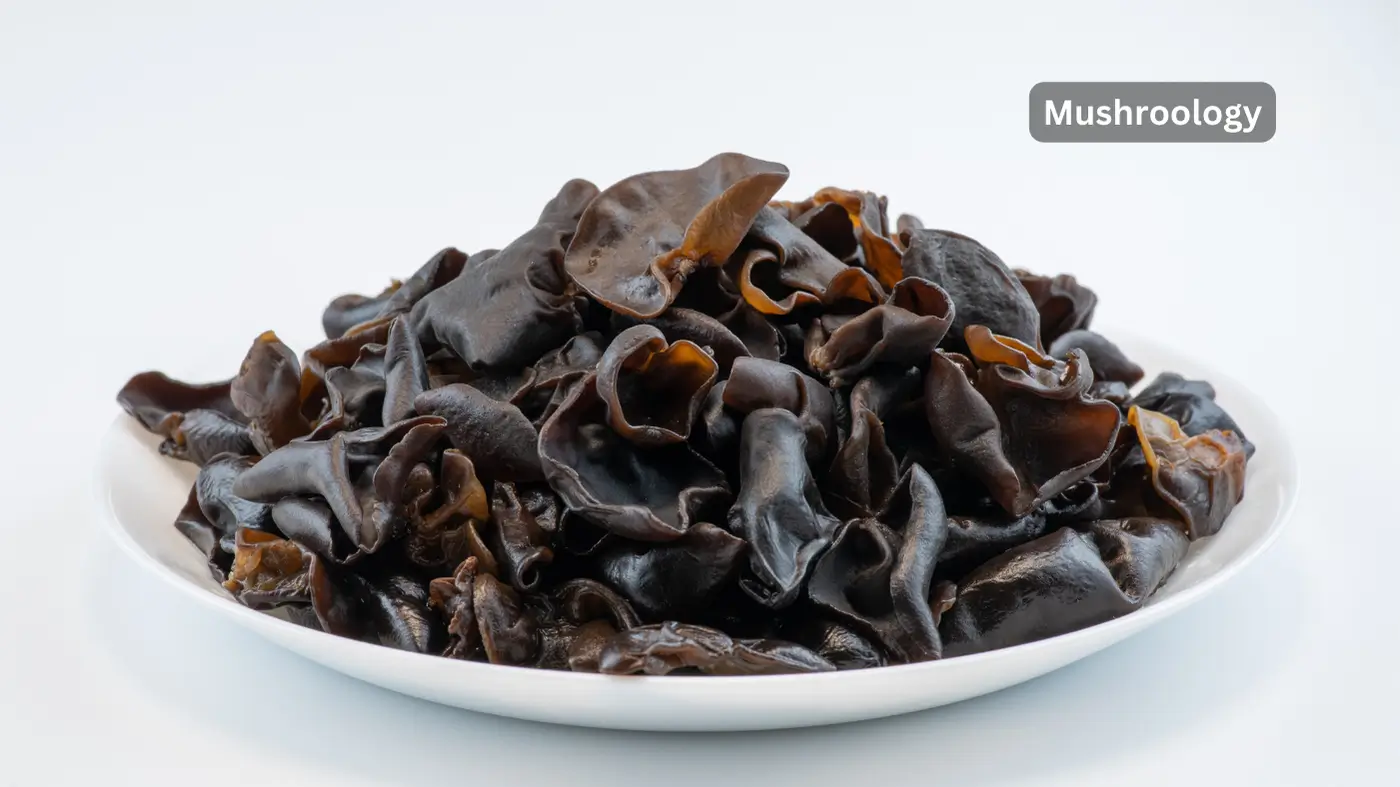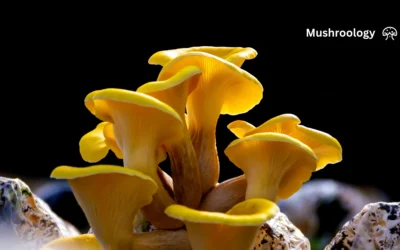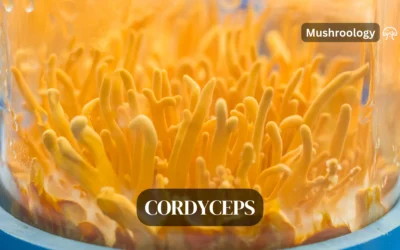Wood ear mushrooms, also known as black fungus, jelly ear, or tree ear mushrooms, are a culinary delight and packed with numerous health benefits. These mushrooms have been used in traditional Chinese medicine for centuries and are now gaining recognition worldwide for their nutritional and medicinal properties. Here’s an in-depth look at the health benefits of wood ear mushrooms and why you should consider incorporating them into your diet.
1. Powerhouse of nutrients
Wood ear mushrooms are a powerhouse of essential vitamins and minerals:
Low in Calories and Fat: With only about 20-25 calories per serving, wood ear mushrooms are an excellent low-calorie food option.
Rich in B Vitamins: They are particularly high in B vitamins such as riboflavin (B2), pantothenic acid (B5), and folate (B9), which are crucial for energy metabolism and red blood cell formation.
Minerals: These mushrooms provide significant amounts of copper, iron, magnesium, selenium, and zinc, all of which play vital roles in various bodily functions.
2. Wood ear mushrooms are rich in antioxidants
Wood ear mushrooms are rich in antioxidants, which help protect your body from damage caused by free radicals:
- Selenium: This mineral acts as a potent antioxidant, supporting heart health, joint health, and the immune system.
- Polysaccharides and Flavonoids: These compounds have been linked to antioxidant activity, potentially reducing the risk of chronic diseases and supporting overall well-being.
3. Wood ear mushrooms provide immune system support
The polysaccharides found in wood ear mushrooms have immunomodulatory effects, meaning they can help regulate and boost the immune system:
- Beta-Glucans: These compounds stimulate the activity of phagocytes, immune cells that ingest harmful particles, bacteria, and dead or dying cells, enhancing the body’s defense mechanisms.
- Prebiotics: Wood ear mushrooms contain prebiotics that feed beneficial gut bacteria, promoting digestive health and maintaining bowel regularity.
4. Heart Health
Wood ear mushrooms contribute to cardiovascular health in several ways:
- Cholesterol Management: The dietary fiber and polyphenols in wood ear mushrooms help lower LDL (bad) cholesterol levels, which can reduce the risk of heart disease.
- Blood Clotting: Compounds like adenosine and polysaccharides in these mushrooms inhibit blood clotting and platelet aggregation, improving circulation and potentially preventing heart attacks and strokes.
5. Blood Sugar Regulation
For individuals concerned about blood sugar levels, wood ear mushrooms may offer benefits:
- Steady Blood Glucose Levels: Hot water extracts of wood ear mushrooms have been shown to help maintain steady blood sugar levels after meals, preventing spikes in blood glucose.
6. Brain Health
Wood ear mushrooms may also support brain health:
- Inhibition of Beta Secretase: These mushrooms have been found to inhibit the activity of beta secretase, an enzyme that releases beta amyloid proteins linked to degenerative diseases like Alzheimer’s.
7. Anti-Inflammatory Properties
The anti-inflammatory compounds in wood ear mushrooms can help reduce inflammation in the body:
- Chronic Inflammation: By reducing chronic inflammation, these mushrooms may help prevent various health issues, including arthritis and other inflammatory conditions.
How to Clean Wood Ear Mushrooms
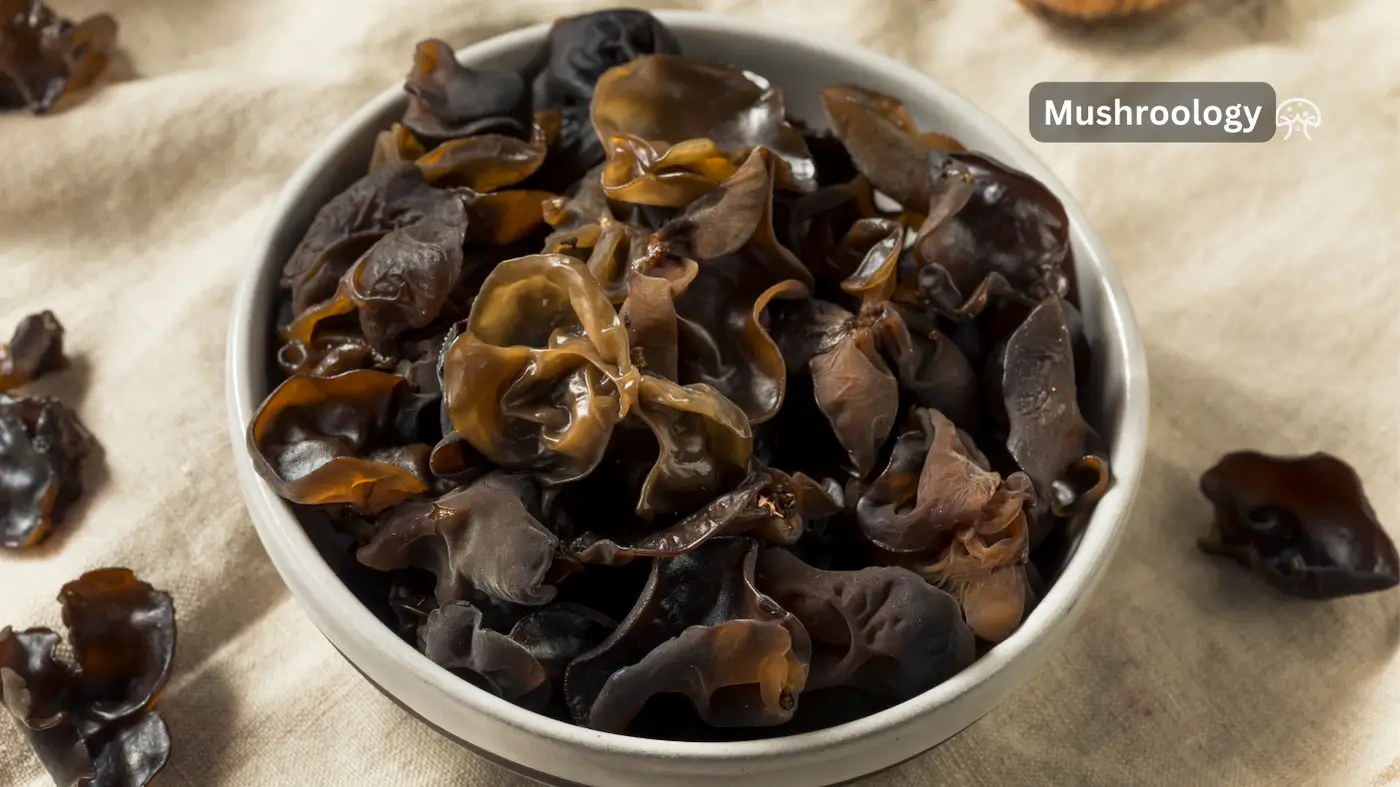
Cleaning wood ear mushrooms is an essential step to ensure they are free from dirt, debris, and any potential contaminants. Here are the detailed steps to clean both dried and fresh wood ear mushrooms:
Cleaning Dried Wood Ear Mushrooms
- Soak the Mushrooms:
Place the dried wood ear mushrooms in a bowl and cover them with warm water. Allow them to soak for about 15-20 minutes until they rehydrate and expand to their original size.
Alternatively, you can use cold water and soak them for about 1 hour or even overnight for a better texture.
- Rinse and Rub:
After soaking, drain the water and rinse the mushrooms under running water.
Rub each mushroom gently between your fingers to remove any dirt or debris hidden in the folds.
- Trim the Tough Parts:
Use a knife or scissors to trim off the tough stems or any hard parts where the mushroom was attached to the wood.
- Final Rinse:
Give the mushrooms a final rinse under running water to ensure they are clean and free from any remaining dirt.
Cleaning Fresh Wood Ear Mushrooms
- Brush or Cloth Method:
Use a dry brush, such as a mushroom brush, pastry brush, or toothbrush, to gently scrub away any dirt or debris from the surface of the mushrooms.
Alternatively, you can use a damp cloth to wipe the mushrooms clean, which allows for a more thorough cleaning without soaking the mushrooms in water.
- Rinse Method:
Place the mushrooms in a colander and rinse them under cold running water. Gently rub the mushrooms with your fingers to remove any dirt.
If the mushrooms are particularly dirty, you can dunk them in a bowl of clean water and swish them around to dislodge any debris.
- Trim the Tough Parts:
As with dried mushrooms, trim off any tough stems or hard parts using a knife or scissors.
- Drying:
After cleaning, pat the mushrooms dry with a clean kitchen towel or paper towels to remove excess water before cooking.
Avoid Over-Soaking: Do not soak the mushrooms for too long as it can affect their texture and may lead to spoilage.
Use Immediately: It is best to use the cleaned mushrooms immediately or within a day to ensure freshness and prevent spoilage.
How to store wood ear mushrooms
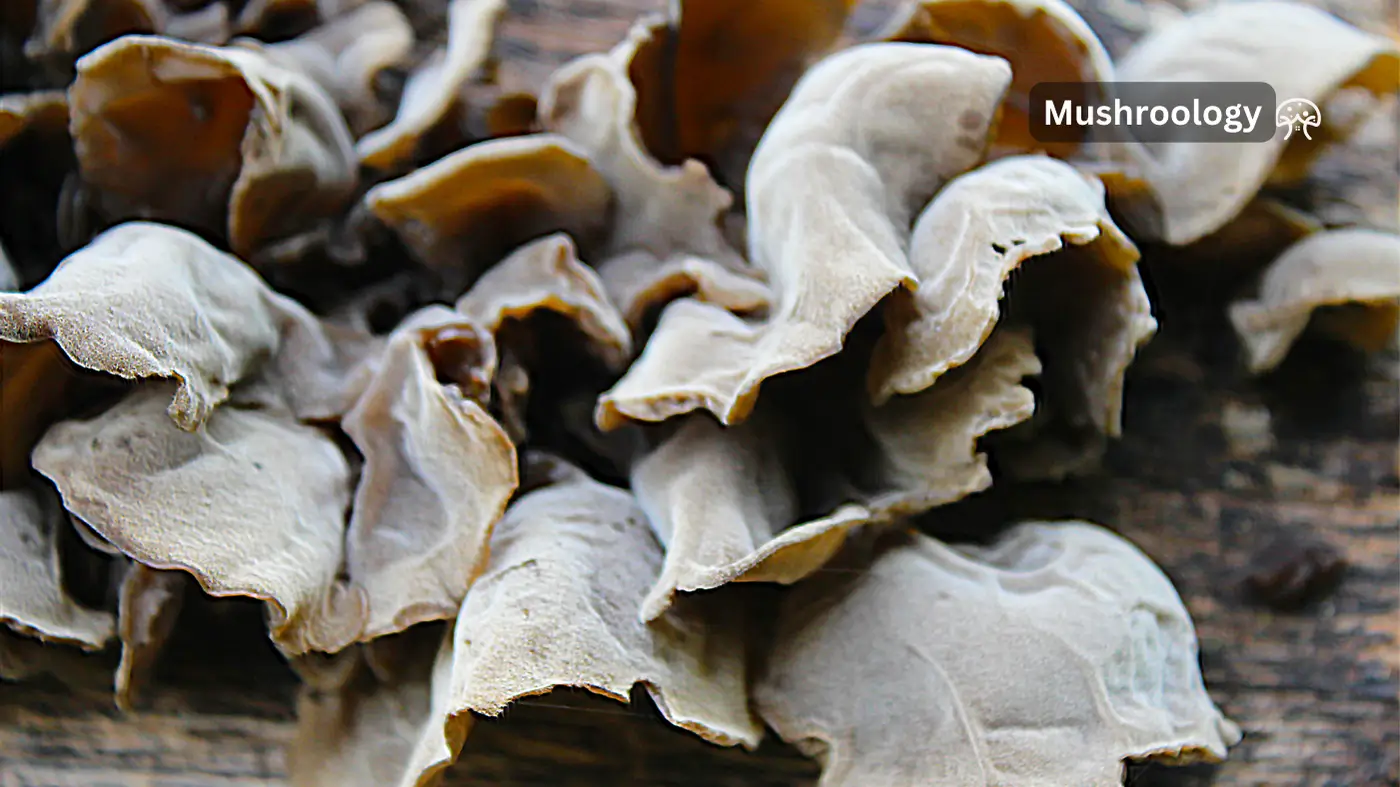
Are you looking to keep your wood ear mushrooms fresh and flavorful for as long as possible? Let’s discover the essential steps to properly store both fresh and dried wood ear mushrooms, ensuring they remain in prime condition for your culinary adventures.
1. Store Fresh Wood Ear Mushrooms
Fresh wood ear mushrooms require careful handling to maintain their texture and prevent spoilage. Here’s how you can store them effectively:
Refrigeration
- Container: Place the fresh wood ear mushrooms in a paper bag or wrap them in paper towels. This helps absorb excess moisture and prevents the mushrooms from becoming slimy.
- Temperature: Store the mushrooms in the main compartment of your refrigerator, where the temperature is consistent. Avoid the door shelves, as temperatures can fluctuate.
- Shelf Life: Fresh wood ear mushrooms can last up to one week in the refrigerator when stored properly.
2. Store Rehydrated Wood Ear Mushrooms
If you’ve rehydrated more wood ear mushrooms than you need, freezing them is the best way to preserve their quality:
Freezing
- Immediate Freezing: Freeze the rehydrated mushrooms immediately to prevent bacterial growth.
- Blanching: Quickly blanch the mushrooms in hot water before freezing to help preserve their texture.
- Storage: Place the blanched mushrooms in a freezer-safe bag or container, removing as much air as possible before sealing.
3. Store Dried Wood Ear Mushrooms
Dried wood ear mushrooms have a long shelf life when stored correctly. Follow these steps to keep them fresh:
Airtight Containers
- Container: Store dried mushrooms in an airtight container, such as a glass jar or resealable plastic bag. This prevents moisture from entering and spoiling the mushrooms.
- Location: Keep the container in a cool, dark, and dry place, such as a pantry or cupboard. Avoid warm locations as heat can reduce their shelf life.
- Shelf Life: Dried wood ear mushrooms can last for six months to a year when stored properly.
Cold Storage
- Refrigeration or Freezing: For maximum shelf life, store dried mushrooms in the refrigerator or freezer. This helps maintain their freshness and prevents spoilage due to heat and moisture.
- Preparation: Before using dried mushrooms, rehydrate them by soaking in warm water for 15-30 minutes until they regain their original texture.
How Long Do Wood Ear Mushrooms Last?
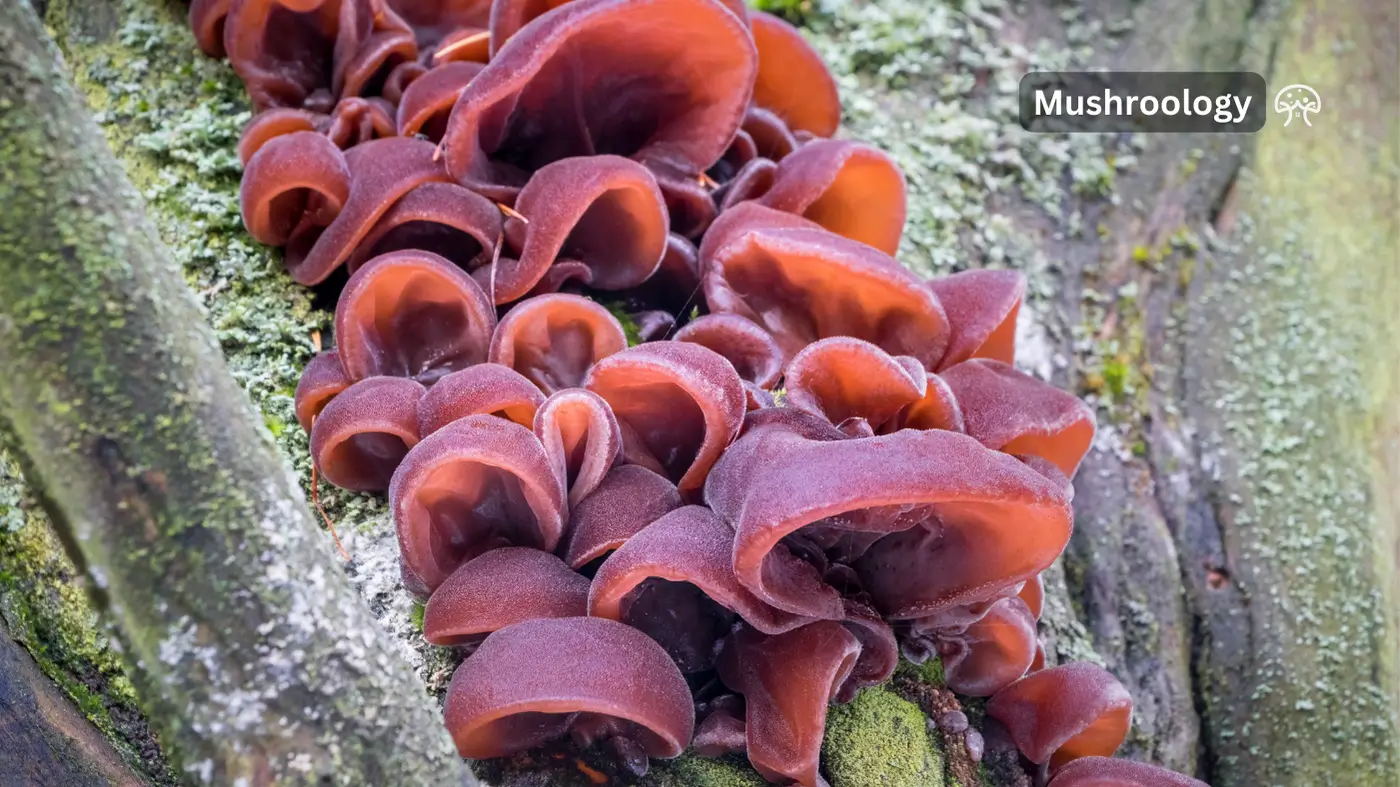
Understanding the shelf life of wood ear mushrooms is crucial for ensuring their freshness and safety. Whether you have fresh, dried, or rehydrated wood ear mushrooms, knowing how long they last and how to store them properly can make all the difference.
1. Fresh Wood Ear Mushrooms
Fresh wood ear mushrooms have a relatively short shelf life and need to be stored properly to maximize their freshness.
Refrigeration
- Whole, Uncooked: Fresh wood ear mushrooms can last for 7 to 14 days when stored in the refrigerator. Place them in a paper bag or wrap them in paper towels to absorb excess moisture and prevent them from becoming slimy.
- Sliced, Uncooked: If you’ve already sliced the mushrooms, they will last for about 5 to 7 days in the fridge.
- Cooked: Cooked wood ear mushrooms should be consumed within 3 to 5 days when stored in the refrigerator.
2. Rehydrated Wood Ear Mushrooms
Rehydrated wood ear mushrooms have a very short shelf life due to their tendency to attract bacteria that produce toxins.
Refrigeration
- Short-Term: After rehydrating, wood ear mushrooms should be used within 3 to 4 days if stored in a covered dish or container in the refrigerator.
- Freezing: For longer storage, it is recommended to freeze rehydrated wood ear mushrooms immediately. This helps prevent bacterial growth and preserves their texture. Blanch them quickly in hot water before freezing for best results.
3. Dried Wood Ear Mushrooms
Dried wood ear mushrooms have the longest shelf life and are the most convenient for long-term storage.
Airtight Storage
- Shelf Life: When stored in an airtight container in a cool, dry, and dark place, dried wood ear mushrooms can last for 1 to 2 years. This method prevents moisture from entering and spoiling the mushrooms.
- Freezing: For maximum shelf life, store dried mushrooms in the freezer. This can extend their shelf life to up to 3 years.
How to maximize Shelf Life of wood ear mushrooms?
- Humidity and Ventilation: Ensure a balance between humidity and ventilation. Too much humidity can promote mold growth, while inadequate humidity can cause the mushrooms to dry out and shrivel.
- Temperature Consistency: Keep your storage area at a consistent temperature to prevent spoilage. For fresh mushrooms, the refrigerator should be set at or below 40°F (4°C).
- Avoid Washing Before Storage: Do not wash fresh mushrooms before storing them, as this can cause them to absorb water and spoil more quickly.
- Regular Inspection: Regularly check stored mushrooms for any signs of spoilage, such as mold, an off smell, or a slimy texture, and discard any affected pieces to prevent contamination.
Can You Eat Wood Ear Mushrooms Raw?
While it might be tempting to try wood ear mushrooms raw, it’s best to cook them to ensure they are safe to eat and to enjoy their full range of textures and flavors.
Why You Shouldn’t Eat Wood Ear Mushrooms Raw
Bacterial Contamination
One of the primary reasons to avoid eating wood ear mushrooms raw is the risk of bacterial contamination. Raw wood ear mushrooms can harbor harmful bacteria that may lead to foodborne illnesses. Cooking the mushrooms thoroughly helps to eliminate these bacteria, making them safe to eat.
Digestive Issues
Consuming raw wood ear mushrooms can also cause digestive discomfort. The mushrooms have a tough, gelatinous texture that can be difficult to digest when not cooked. Cooking helps to soften the mushrooms, making them easier on your digestive system.
What Does Wood Ear Mushroom Taste Like?
Wood ear mushrooms, are a unique ingredient in many Asian cuisines. While they may not be known for their strong flavor, their distinctive texture and ability to absorb the flavors of the dishes they are cooked with make them a versatile and valued component in various recipes.
Mild and Earthy
Wood ear mushrooms have a very mild flavor, often described as slightly earthy or woodsy. This subtle taste allows them to blend seamlessly into a variety of dishes without overpowering other ingredients. They are particularly good at absorbing the spices and nuances of the dishes they are added to, making them a versatile ingredient in many culinary applications.
Savory Umami
While the mushrooms themselves do not impart a strong flavor, they do have a hint of savory umami, which can enhance the overall taste of a dish. This makes them a great addition to soups, stews, and stir-fries where they can soak up the flavors of the broth and seasonings.
Texture
The texture of wood ear mushrooms is one of their most distinctive features and is often the main reason they are included in recipes:
Crunchy and Gelatinous
- Crunchy: When cooked, wood ear mushrooms maintain a firm, crunchy texture that adds a pleasant contrast to softer ingredients in a dish. This crunchiness is particularly appreciated in dishes like hot and sour soup, stir-fries, and salads.
- Gelatinous: They also have a slightly gelatinous, jelly-like consistency, which can provide a unique mouthfeel. This texture is often described as slippery but pleasant, adding an interesting dimension to the dishes they are included in.
Are There Any Known Side Effects of Consuming Wood Ear Mushrooms?
Here’s a detailed look at the known side effects of consuming wood ear mushrooms and precautions you should take.
1. Allergic Reactions
While allergic reactions to wood ear mushrooms are relatively rare, they can occur, particularly in individuals who are sensitive to fungi. Symptoms of an allergic reaction may include:
- Itching
- Swelling
- Rash
- Difficulty breathing
If you experience any of these symptoms after consuming wood ear mushrooms, seek medical attention promptly.
2. Digestive Distress
Some people may experience digestive discomfort after consuming wood ear mushrooms. This can include:
- Bloating
- Gas
- Upset stomach
If you are trying wood ear mushrooms for the first time, it’s advisable to start with a small portion to gauge your body’s response.
3. Interactions with Medications
Wood ear mushrooms could potentially interact with certain medications, particularly:
- Blood-thinning medications: Wood ear mushrooms have natural anticoagulant properties, which can enhance the effects of blood-thinning medications and increase the risk of bleeding.
- Medications affecting blood sugar levels: If you are taking medications for diabetes, consult your healthcare provider before incorporating wood ear mushrooms into your diet, as they may affect blood sugar levels.
4. Contaminant Risk
Wild-harvested wood ear mushrooms can carry the risk of contamination with harmful substances from their environment. It’s advisable to purchase wood ear mushrooms from reputable sources that follow proper harvesting and handling practices. Contaminated mushrooms can lead to foodborne illnesses, so proper cleaning and cooking are essential.
5. Culinary Precautions
Improper preparation of wood ear mushrooms can result in an unappetizing, rubbery texture. To avoid this:
- Rehydrate dried mushrooms properly: Soak them in warm water until they are soft and pliable.
- Cook thoroughly: Always cook wood ear mushrooms before consuming them to kill any potential bacteria and improve their texture.
6. Risk of Anaphylaxis
In rare cases, wood ear mushrooms can cause anaphylaxis, a severe and life-threatening allergic reaction. This is caused by proteins in the mushrooms that can trigger a severe immune response.
Symptoms include severe hypotension, difficulty breathing, and loss of consciousness. If you have experienced anaphylaxis after consuming wood ear mushrooms, avoid them entirely and consult a healthcare professional.
While wood ear mushrooms offer numerous health benefits, it’s important to be aware of their potential side effects.
Always start with a small portion if you are trying them for the first time, and consult your healthcare provider if you are on medication or have known allergies. Proper handling, cleaning, and cooking are crucial to avoid any adverse effects and to enjoy the unique texture and mild flavor of wood ear mushrooms safely.

